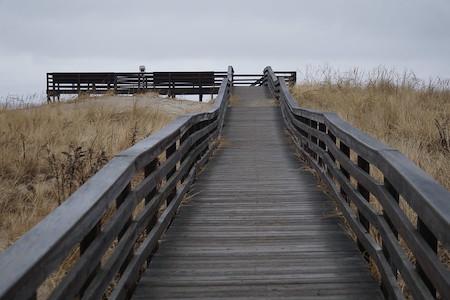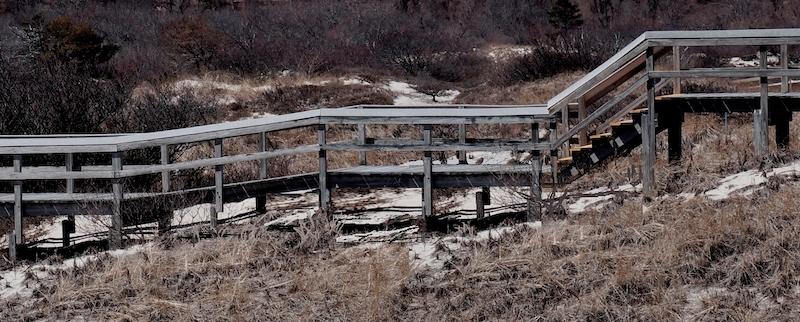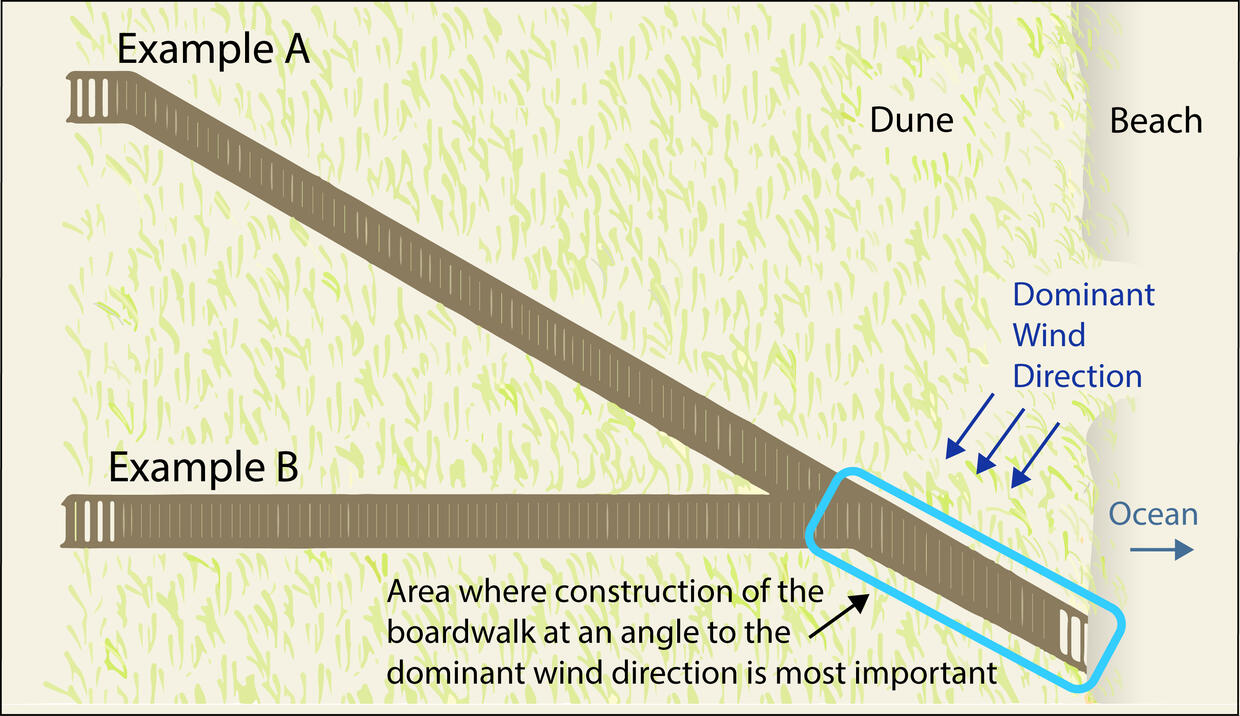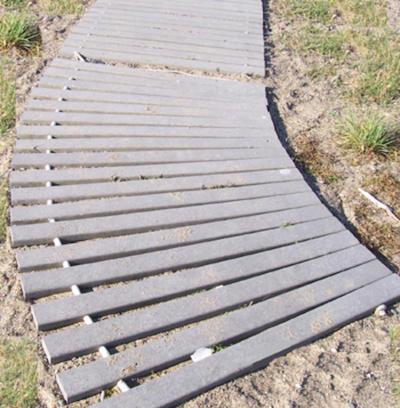Boardwalks, walkways, stairways, and other structures that provide beach access over dunes and banks can cause erosion and increase storm damage if not properly designed. Potential problems include limiting the growth of plants that stabilize the shoreline and creating wind and water channels that lead to scour, erosion, and flooding of landward properties. Properly designed access structures not only minimize these impacts, but actually provide significant benefits—they help to define and maintain pedestrian access in one location, discourage widespread trampling of vegetation, allow for the natural movement of sand and other sediment, and stabilize dunes and banks to help protect coastal properties from waves, wind, erosion, storm surge, and flooding.
This tip covers the importance of vegetation for dune and bank stability, the benefits of elevated access structures, permitting requirements, and recommended design and construction methods for access structures.
Vegetation and Dune and Bank Stability
Salt-tolerant plants with extensive root systems help stabilize dunes and banks—roots hold sediments in place and leaves and stems absorb water, break the impact of raindrops or wave splash, and slow and diffuse the flow of overland runoff. Plants can also help trap windblown sand, which is particularly important for building dunes and buffering inland areas from storm waves, erosion, and flooding. For more information on the benefits of coastal plants on dunes and banks, see the Massachusetts Office of Coastal Zone Management's (CZM) StormSmart Properties Fact Sheet 3: Planting Vegetation to Reduce Erosion and Storm Damage.
American beachgrass is particularly useful for stabilizing dunes because it is extremely hardy and grows readily on the coast. In addition, its fast-growing rhizomes (underground stems) effectively stabilize sediments and allow for quick establishment of new plants. (For more on the benefits of beachgrass for dune stability, see CZ-Tip - Dune Building with Beachgrass.)
Elevated Structures
- Pathways at ground level do not define and designate pedestrian access to the beach as clearly as elevated structures and can lead to the trampling of nearby beachgrass and other stabilizing vegetation. In addition, since low pathways are not always clearly visible, pedestrians often inadvertently create additional pathways to get to the beach. Dune plants, including beachgrass, are vulnerable to being trampled—walking directly over or through a dune can kill dune plants and create landslides, bare spots, and the potential for dune blowouts (i.e., areas where strong winds “blow out" sand and form a depression), as well as lower the overall height and stability of the dune. Walking over banks can also kill vegetation, leading to landslides, erosion, and reduced bank stability.
Boardwalks, walkways, and stairways are therefore preferable to at-grade pathways. Not only are they clearly visible and defined, they also allow for the growth of stabilizing vegetation and the natural movement of sand and sediments beneath them. (In some circumstances, however, at-grade rollout structures used on a seasonal basis are a good option—see “Sectional, Adjustable, and Temporary Design Elements” below for more information.)
Permits First!
Because activities on the coast can easily impact natural resources and neighboring properties, they are strictly regulated. The construction or replacement of a boardwalk, walkway, or stairway on or near a dune, bank, or beach will require a permit under the Massachusetts State Building Code, as well as a permit through your local Conservation Commission and the Massachusetts Department of Environmental Protection's (MassDEP) Wetlands and Waterways Program. (Contact your city or town for local permit applications and requirements.) Though a permit is required, the Wetland Protection Act Regulations allow and encourage pedestrian walkways on dunes, provided that they are designed to minimize the disturbance to vegetation and promote the ability of dunes to move, shift, and migrate. Construction of structural accessways may also warrant review by the Natural Heritage and Endangered Species Program (NHESP) to ensure there are no conflicts with bird nesting habitat or other species requirements. Depending on project location and the work involved, other permits or approvals may also be required, such as under the state’s Chapter 91: Public Waterfront Act and its Waterways Regulations (310 CMR 9.00) and the federal Rivers and Harbors Act and Program Regulations.
Design and Construction Tips
To rebuild pedestrian accessways in a way that minimizes impacts to coastal dunes and banks, follow these design and construction guidelines:
- Size - Overly large structures on coastal dunes and banks limit growth of beachgrass or other salt-tolerant vegetation. In general, boardwalks, walkways, and stairways should be no wider than 4 feet (and preferably narrower) and extend no longer than necessary to provide access to the beach (see “Orientation” below for more details).
- Elevation - Sufficient elevation is important for plant growth and to allow the natural movement of sand and other sediments under and around the structure. For dunes, elevating the structure on posts or pilings without footings—and at least 2 feet above the grade of the surrounding dune—will allow for easy movement of sand or sediments, dune growth, and enough sunlight to penetrate under the structure for plant growth. It is important to elevate the access structure 2 feet above the grade of the surrounding dunes (and not just 2 feet above the dune directly below the structure) to ensure elevation is maintained after the dune builds back up. For banks, elevating the structure at least 2 feet above grade allows for the growth of stabilizing vegetation and the natural movement of bank sediments to feed area beaches.
- Additional Options for Increasing Sunlight - The elevated structure can be built with additional elements that help reduce shading impacts on plants. Sections of metal grate with openings can be used for the walkway’s surface, or planks can be spaced 1 inch apart (enough space to allow sunlight to penetrate under the structure, but not enough to impede safe access on the walkway). For stairways, using treads without risers will also reduce shading effects on plants.
- Orientation - Avoid the creation of damaging wind or wave tunnels by properly orienting the boardwalk, walkway, or stairway across the dune. The recommended approach is to construct the structure at an angle away from the dominant wind and wave direction (see Example A in the figure below). As long as the walkway section closest to the beach is oriented in this manner, a break in the angle can be constructed in the more sheltered area further inland to reduce the length of the walkway (see Example B).
- Sectional, Adjustable, and Temporary Design Elements - Access structures can be built with elements to reduce impacts over time, such as the use of breakaway sections to minimize impacts to the stability of the underlying dune or bank if a section is destroyed. An alternative to permanent elevated structures on dunes is the seasonal use of roll-out, at-grade, sectional boardwalks. These temporary structures can be removed during the off-season to reduce the potential for storm debris and to allow the dune to function unimpeded when wind-driven sediment transport is generally higher and the demand for beach access is reduced.
- Reducing Overland Runoff Issues - Another consideration, particularly on coastal banks, is overland runoff (rainwater, snowmelt, and water from irrigation systems and other sources that does not soak into the ground or evaporate, but instead flows over the ground surface). Generally, runoff should be redirected away from the top of the bank, particularly at the access point of the structure, to avoid creating a gully and erosion of the bank face. The area under the walkway can also be planted to stabilize the soils and sediments. See CZM’s StormSmart Properties Fact Sheet 2: Controlling Overland Runoff to Reduce Coastal Erosion for more information.
- Time of construction - Construction activities should be timed to minimize or avoid impacts if they are in or adjacent to endangered or threatened species habitat (contact NHESP for additional information). In addition, construction that will remove plant cover and expose areas to erosion during the storm season (winter) is not recommended. When planting, allow enough time for beachgrass to grow in the spring or fall to be able to provide protection and stability to the underlying landform.
- Materials - When deciding the type of construction material to use for your structure, consider materials that will resist rot and other deterioration. Though pressure treated wood is effective, it contains arsenic, which poses health risks to you and the environment. See MassDEP’s Q&A: Pressure Treated Wood page for information on the health risks associated with this product. Other options include non-arsenic-containing hardwoods (such as cedar and redwood), wood composites, and non-wood alternatives such as metals and plastics.
- Maintenance - General maintenance is typically required to ensure the longevity of the structure, such as repairing and replacing sections. Any components of the structure that are damaged or broken should be removed to ensure public safety and natural sediment movement.



